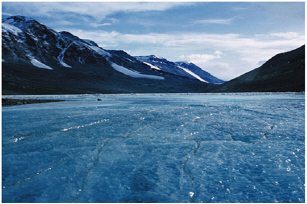4
Exploring Scientific Frontiers
“Never lose a holy curiosity.”
ALBERT EINSTEIN
Exploration of the unknown has been a vital part of humanity’s interaction with the polar environment since the first people lived and hunted in the Arctic thousands of years ago. Heroic tales of exploration are filled with adventurers from the polar regions—Amundsen, Byrd, Hensen, Nansen, Scott, and Shackleton are but a few of the many famous explorers. In earlier International Polar Year (IPY) and International Geophysical Year (IGY) research programs, science-driven exploration of new geographical regions was a major activity. In the IPY 2007-2008, only limited regions of Earth’s surface, such as parts of East Antarctica, remain to be explored in the traditional geographic sense. But vast regions of the seafloor and ocean remain unexplored, and the least explored of the oceans are the Arctic and Southern. New frontiers and challenges loom as exploration activity takes advantage of new disciplines and technologies that were unknown in the previous IPYs and the IGY. Modern exploration occurs on a tremendous range of spatial scales, from the previously inaccessible realms of the genome to Earth’s mantle, core, and magnetosphere. Fascinating discoveries can be expected.
EXPLORING LIFE IN THE POLAR REGIONS
The extremes of temperature, the ice cover, and the marked seasonal variation in day length that characterize the polar regions confront organisms with a challenging set of environmental conditions. Yet the apparent “hostility” of the Arctic and Antarctic environments has not precluded the evolution of complex ecosystems whose constituent species have adapted in novel ways to the extreme physical conditions they face. Biologists have much to learn from the study of all types of polar organisms, including microbes, the most abundant yet least understood group of species; insects and plants, which have remarkable
abilities to either avoid freezing or to survive the formation of ice in their body fluids; and hibernating mammals, whose capacities to survive near-freezing body temperatures may provide new insights into biomedically important issues such as cold-preservation (cryopreservation) of tissues and whole animals. Many new species of polar organisms remain to be discovered, as shown by the recent finding of new species of invertebrate and vertebrate marine life through the internationally organized Census of Marine Life project.1
The biology of the polar regions thus represents a fascinating frontier for exploration, where rewards in both basic and applied science are waiting (NRC, 2003a). What follows is an overview of some types of exploratory activities in polar biology that seem especially likely to provide important new knowledge about polar ecosystems and the adaptations that make life possible under the extreme physical conditions of the polar regions. Many of the key questions in polar biology can only now be answered because of the development of new technologies, ranging from those of genomics to cold-hardened, remotely operated vehicles (ROVs). The tools are now at hand to explore the biota of the polar regions as never before possible.
Microbiology
We currently know relatively little about the numerically dominant species in the polar regions—the microbes (NRC, 2003a). These diverse species, which comprise members of the Eukarya, Bacteria, and Archaea domains, are involved in virtually all biogeochemical transformations in terrestrial, freshwater, and marine ecosystems of the polar regions. Thus, until we thoroughly explore the microbial world at the polar regions, we will lack the basis for a comprehensive understanding of the functions of polar ecosystems and their susceptibility to climate change and pollution. Our current state of knowledge—or ignorance, to be more accurate—about polar microbes is illustrated by the fact that we are largely unable to answer the following two basic questions: “What types of microbes are present in polar ecosystems?” and “What types of metabolic activities and ecological transformations do polar microbes carry out?”
Our inability to provide detailed answers to these fundamental questions largely reflects past technological limitations to the study of microbial life, limitations that newly developed genomic technologies have mostly eliminated. As discussed in NRC (2003a), genomic methodologies, which are defined as “the study of the structure, content, and evolution of genomes, including the analysis of expression and function of both genes and proteins,” allow identification of species and elucidation of the types of functions their genes and proteins enable them to perform. For example, the types of genomic techniques used by law enforcement agencies in “molecular forensics” can be applied to identifying the diverse types of microbes present in aquatic and terrestrial environments. Other genomic methodologies, such as those that employ bacterial artificial chromosomes, allow characterization of the genes that underlie metabolic

“Black smokers” are fissures in the sea floor that emit scalding hot vent waters, whose temperatures may reach 750°F (400°C). In contrast, the normal ocean bottom water around the smokers is close to 35°F (2°C). While no organisms live in the hottest water coming from the smokers, small worms and crabs snuggle into the warm walls of the chimney. Recent investigations revealed a surprising amount of “black smokers” and associated hydrothermal systems along the Arctic spreading ridges. Biologists are puzzled as to how vent animals adapt to such high pressure and warm temperatures. Microbiologists are especially interested in cultivating “extremophiles,” microbes that can withstand extremely high temperatures and high levels of heavy metals. SOURCE: Jim Childress, University of California, Santa Barbara.
function. Thus, these new DNA-based methods now provide microbiologists with tools to determine what microbes are out there and what roles they play in ecosystems. We are poised to explore the world of polar microbiology in wholly new ways, and this work will open up important new understanding of the pivotal role that microbes play in all polar ecosystems.
Biotechnology and Biomedicine
The remarkable abilities of plants and animals native to polar regions to withstand extremes of low temperature and, in many cases, wide ranges of temperature represent a promising biological frontier for exploration. Genomic technologies offer the prospects of discovering important new mechanisms of adaptation that polar organisms have “invented” during their evolution under physical extremes and of developing ways to exploit these adaptations in biomedical and biotechnological research (NRC, 2003a).
Of particular interest in the context of biomedical research are the abilities of many polar organisms to either avoid freezing or to withstand the formation of ice in
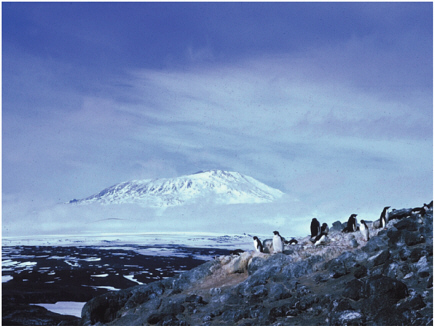
Almost a thousand Adelie penguins live in the Cape Royds rookery on Ross Island in the Antarctic. Rookeries serve as nursery grounds for the young birds. In the background is Mount Erebus, a smoking active volcano. SOURCE: George Somero, Stanford University.
their body fluids. Small mammalian hibernators such as ground squirrels allow their core body temperature to fall to approximately –2°C. Yet these animals do not freeze and they rapidly return to a metabolically active state when the body’s heat-generating mechanisms are activated. Our ability to develop improved methods for low-temperature storage of biological materials—ranging from isolated cells to intact organisms—may depend on acquiring a detailed understanding of the unique physiologies of hibernators. Many polar insects and plants attain even lower cell temperatures in their terrestrial habitats, yet their cells remain ice-free because of the accumulation of antifreeze compounds. Understanding the fundamental mechanisms of freezing resistance will have broad technological applications, ranging from agricultural science (e.g., the design of freeze-resistant crops) to biomedicine (e.g., development of improved cryopreservation techniques). Some polar animals and plants do experience the formation of ice in the extracellular fluids, yet these species appear to be undamaged by this type of freezing. The factors that regulate freezing of extracellular water and protect against damage from ice formation may allow further advances in cryotechnology and biomedicine. The new genomic technologies that have been developed largely in the context of biomedical research offer a remarkable new set of tools for polar biology, tools that will allow contributions to be made in both basic and applied research.
|
Polar Ecosystems Who could have predicted that the study of polar ecosystems would reveal fishes that, unique among vertebrates, lack red blood cells; hibernating mammals whose body temperatures plummet below 32°F (0°C) in winter; algae, living within ice and quartz-containing rocks, that may be metabolically active for only hours each year; fish whose blood remains in the liquid state at subzero temperatures because of the presence of novel biological antifreeze proteins; insects that are able to crawl on the snow at temperatures of –58°F (–50°C), and large subglacial lakes, isolated from the rest of the biosphere for many millions of years, that may hold a variety of ancient forms of life? |
Polar Ecology
Inasmuch as new technologies offer the means to explore the genomes and physiologies of polar species, new tools are becoming available that allow novel types of exploration of large and complex terrestrial and aquatic ecosystems in the polar regions (NRC, 2003a). Newly developed electronic tagging technology enables the movements
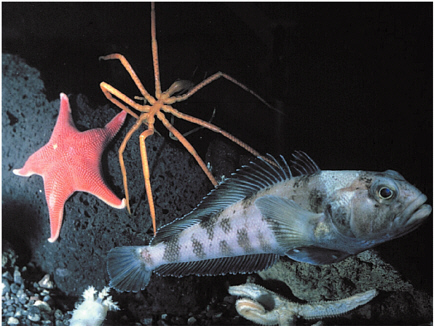
A wide variety of animals thrive in the ice-cold waters of the Antarctic Ocean and play key roles in the marine food web. Here, the notothenioid fish Trematomus bernacchii swims past a sea spider, pycnogonid, and a sea star. SOURCE: George Somero, Stanford University.
|
Surviving Winter at the Polar Regions Evolutionary processes have created many biological communities that are as stunning in their beauty and complexity as they are unexpected by and novel to biological scientists. The Arctic ground squirrel and the black bear are two of many such models of polar species with mysterious mechanisms for surviving extreme environments. In this case the animals enter a state of suspended animation called hibernation. Understanding how this happens may one day provide huge medical benefits that help alleviate human suffering. The black bear, for example, survives polar winters without eating or drinking for as long as six to eight months by lowering its metabolism. Unlike humans, however, who experience significant bone loss if immobilized for extended periods of time, the bear maintains bone mass. By unraveling the biology behind how bone is preserved, biologists will be one step closer to preventing osteoporosis in chronically bedridden patients and others prone to this condition. In contrast to the black bear, whose body temperature drops by about 9°F (5°C) during hibernation, the Arctic ground squirrel’s body temperature plummets as much as 72°F (40°C) to attain a below-freezing core body temperature of about 28°F (–2°C). Interestingly, blood flow to tissues during this period is reduced by as much as 98 percent for up to three weeks, and yet no tissue damage occurs. If biologists can find the biochemical pathways that afford cells protection from low blood flow, they may be able to protect individuals from injury due to strokes and heart attacks when reduced oxygen is available to cells (Becker et al., 2002; Boyer and Barnes, 1999). |
of animals to be tracked remotely over long distances, providing important information about the sites at which species feed and reproduce and the physical conditions of the environment (temperature and light levels). Satellites may provide an important link in these tracking studies, further emphasizing the role of these space-based platforms in polar research. New, cold-hardened models of remotely operated vehicles being deployed in polar oceans are providing rare insight into the unknown biology of these seas, finding new species of life and allowing studies of modes of adaptation by these organisms to these extreme environments. Genomic techniques can be used to analyze the genetic structures of populations of plants and animals, revealing whether genetically distinct populations occur in habitats with different environmental characteristics. And, as discussed above, the recently acquired abilities to determine the types of microbes present in an ecosystem and to elucidate the physiological activities of these important organisms open up an especially important new avenue of exploration in polar ecosystems.
EXPLORING NEW REGIONS
Subglacial Lake Environments
Recent discoveries show that buried under miles of Antarctic ice are subglacial lakes ranging in size from Lake Vostok (Figure 4.1), a body the size of Lake Ontario, to shallow frozen features the size of Manhattan. Over 100 lakes, both shallow and deep, have now been identified, suggesting that the subglacial environment is a previously unrecognized immense, possibly interconnected, hydrological system. The extent and degree of interconnection among the lakes are unknown. These recently discovered
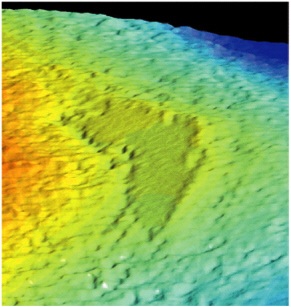
FIGURE 4-1 Perspective view of the ice surface above subglacial Lake Vostok based on ERS-1 radar altimetry data. The ice above Lake Vostok shows as the flat, featureless region in the center of the image. SOURCE: Michael Studinger, Lamont-Doherty Earth Observatory of Columbia University.
subglacial environments formed in response to the complex interplay of tectonics and topography with climate and ice sheet flow over millions of years.
The temperatures and pressures of subglacial lakes are relatively moderate, similar to the environment of the deep oceans. However, subglacial environments are unique hemispheric-scale laboratories found nowhere else on Earth. Sealed from free exchange with the atmosphere for 10 million to 35 million years, subglacial environments are the closest Earth-bound analogs to the icy domains of Mars and Europa (Siegert et al., 2001).
Tantalizing evidence from studies of the overlying ice sheet indicates that unique life-supporting ecosystems may be locked within these subglacial environments (Priscu, 2002; Priscu et al., 2002). Such life forms must be adapted to the temperatures and pressures akin to the deep ocean, as well as the extremely slow delivery of nutrients from the overriding ice sheet. These subglacial environments provide an unparalleled opportunity to advance our understanding of how climatic and geological factors have combined to produce a unique and isolated biome that may be occupied by yet unknown microbial communities.
Subglacial lake exploration poses one of the most challenging scientific, environmental, and technological issues facing polar science today. Many engineering issues need resolution, sensors and instrumentation must be developed, and environmental assurance must be demonstrated before scientific exploration is feasible. IPY 2007-
2008 will spawn new technologies and partnerships that can accelerate solving these challenges, leading to fundamental discoveries about life and climate on Earth and the associated implications for other planets.
Subglacial Lands
The lands beneath the ice sheets of Antarctica and Greenland remain poorly understood and largely unexplored, yet the geological and hydrological characteristics of these subglacial regions are vital for understanding ice sheet development. The nature of the underlying bedrock is a crucial boundary condition that defines the stability of the ice sheet to climatic changes. The subglacial topography is key to ice sheet models in part because the distribution of highlands strongly defines when, where, and how glaciation initiates (DeConto and Pollard, 2003). Much of the subglacial lands in Antarctica and Greenland remain unexplored, so our understanding of how these regions became icebound remains unconstrained.
Major regions of Antarctica that are crucial to deciphering the intertwined geodynamic/climatic history puzzle remain to be explored for the first time. For example, the Gamburtsev Mountains in East Antarctica cover an immense region the size of Texas, yet detailed topography and peak elevation of the mountains remain matters of conjecture. Climate models suggest that the high elevation of these mountains was crucial in localizing the first Cenozoic ice sheets that formed 34 million years ago (Figure 4.2). This onset of glaciation affected the entire Earth, as global climate changed from the hothouse world of the early Cenozoic to the more recent world in
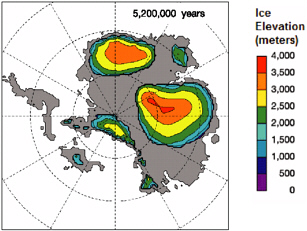
FIGURE 4-2 Glacial ice elevation in Antarctica 5.2 million years ago following a decrease in the level of carbon dioxide in the atmosphere, from the coupled climate-ice sheet model of DeConto and Pollard (2003). This model simulates the glaciation following global cooling 34 million years ago. Glaciers first formed in the East Antarctic highlands and moved outward to encompass the entire continent. SOURCE: DeConto and Pollard (2003).
which whole continents are covered in ice. Learning the geological history of the Gamburtsev Mountains enables understanding of how their elevation may have affected climate evolution through the Cenozoic. Clarification of the processes involved in Gamburtsev Mountains uplift will place constraints on the origin of paleotopography of East Antarctica and its possible role in localizing initial glaciation.
Important questions remain concerning the relationship between West Antarctic tectonics and the stability of the West Antarctic Ice Sheet. Previous radar imaging work suggests possible ongoing volcanism and active continental extension in the West Antarctic Rift System (Bell et al., 1998; Anandakrishnan et al., 1998; Blankenship et al., 1993). However, little is known about this volcanism, and the possible role of elevated heat flow from the continental extension in enhancing flow in the overlying ice streams has not been evaluated. Other research topics in need of investigation involve subglacial geology and heat flow in Greenland, via the northeastern Greenland Ice Stream and the processes involved in sub-ice-shelf environments, melting, and circulation. Exploration of subglacial lands and environments will provide much-needed constraints on the evolution of climate-ice sheet systems.
Ocean Basins
The polar ocean basins beneath sea ice represent vast unexplored regions that can now be studied with modern technology, such as remotely operated vehicles and autonomous underwater vehicles. These advances will allow biologists to investigate questions about variations in ecosystems between the ice edge and regions deep within the ice pack and the types of seasonality found beneath floating ice shelves. Recent ocean exploration studies in the Arctic have found new species in both the column and the sediments, emphasizing the “spacelike” unknown environments still common in the extreme environments of Earth. How organisms have evolved to adapt to cold isolated environments will provide important understanding of the processes necessary for life in this extreme environment. In addition, subsea ice exploration can clarify the seasonal changes in both continental shelf dynamics and shelf break upwelling in polar marine seas. These have been argued to result in a major impact on uptake of carbon dioxide as well as global thermohaline circulation.
The Gakkel Ridge in the Arctic Basin is the slowest spreading midocean ridge on Earth, yet study has been limited to only a few submarine and icebreaker expeditions from 1995 to 2003. Study of the Arctic Basin ridges will provide important end-member constraints on ridge processes that vary with spreading rate. The few previous expeditions suggest that the Gakkel Ridge has the thinnest-known oceanic crust. However, some sites display abundant hydrothermal and volcanic activity, and the ridge exhibits long-lived segmentation controlled by mantle processes. These long-lived hydrothermal ecosystems may have been cut off from the rest of the oceanic ecosystem for a long time, since the ridge segments are isolated. Thus, the deep-water vent fauna ecosystems may contain a large number of endemic species and provide constraints on the genetics and evolution of seafloor organisms.
The tectonic history of the Arctic Basin is relevant for understanding past ocean circulation and climate, yet very little is known about it. Exploration of this ocean floor will clarify the geological history of these regions and allow reconstruction of Arctic tectonics and its influence on ocean circulation. The tectonic history of ocean gateways, which allow passage of warm or cold currents between oceans, is useful for
understanding climate in both Arctic and Antarctic regions. For example, Fram Strait, between Svalbard and Greenland, is the only deep-water gateway between the Arctic basin and the global oceans and the date of its formation is unknown. Similarly, constraints on the opening history of Australia-Antarctica and South America-Antarctica gateways will allow better understanding of the onset of the Antarctic Circumpolar Current and its effects on climate and biological evolution.
Earth’s Deep Interior
Earth’s deep interior holds many clues to understanding the planet’s processes and history. The recent development of imaging techniques such as seismic tomography now allows important details of Earth’s interior beneath the polar regions to be resolved for the first time. For example, the surface elevation of East Antarctica is a key factor for localized glaciation. The reason for this anomalous elevation is unknown and may be the result of compositional, thermal, or dynamic buoyancy in the mantle. Detailed seismic imaging of the mantle will resolve this question.
Exploring Earth’s interior will also help constrain coupled climate-icesheet models that require knowledge of basal heat flow and mantle viscosity. Heat flow is an important parameter since ice viscosity is strongly temperature dependent and mantle viscosity controls the rate of terrestrial response to ice loading. The temperature of the upper mantle, estimated from seismic velocity maps (Figure 4.3), suggests a difference
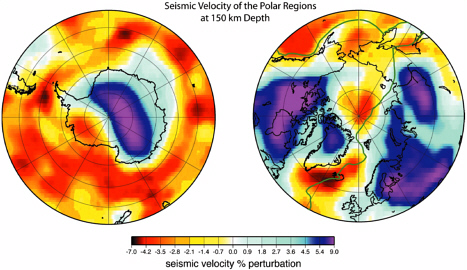
FIGURE 4-3 Map showing seismic velocities at a depth of 150 kilometers beneath the polar regions. Red colors denote slow velocities associated with hot and upwelling regions in the mantle, and blue colors denote fast velocities resulting from cooler temperatures and down-welling regions. The warmer mantle regions are associated with magma production, polar volcanism, rapid postglacial rebound, and increased heat flow beneath glaciers. SOURCES: Ritzwoller et al. (2001) and Shapiro and Ritzwoller (2002).
of about 600°C between East and West Antarctica at a depth of 150 kilometers. These temperature differences have a profound effect on heat flow and mantle viscosity influencing ice sheet models.
Imaging the Earth’s interior can also provide constraints on the origin and spatial distribution of magma sources for polar volcanism because melt-producing regions are characterized by low seismic velocity. Mapping the distribution of melt-producing regions and mantle flow patterns beneath the Iceland hotspot and the slow oceanic spreading centers of the Arctic basin is possible. The increased magmatism and mantle flow associated with the Iceland hotspot may have had a large effect on the tectonic and climatic evolution of Greenland and the Arctic basin. Investigation of mantle anomalies beneath the Gakkel Ridge may provide the first direct evidence of the distribution of melt production regions along an ultra-slow-spreading center.
Exploring the core of our planet is essential for understanding the initial differentiation of the Earth, the Earth’s thermal history, and the physics and variability of the Earth’s magnetic field. The inner core, which solidified from the liquid outer core as the Earth cooled, shows seismic anisotropy approximately aligned with the Earth’s rotation pole. Thus, seismic phases traveling along polar paths show much smaller travel times than the same phases traversing the inner core along equatorial paths. This anisotropy results from the preferential orientation of iron crystals, which may be caused by alignment due to convection patterns in the core. Observations of polar path seismic waves also suggest that the inner core rotates slowly relative to the Earth’s
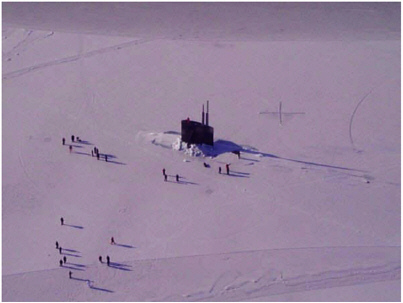
The submarine USS Hawkbill broke through the Arctic ice in April 1999 while on a science mission conducted with the National Science Foundation. During the cruise and associated ice camp, researchers made a variety of physical, chemical, and biological measurements and military personnel gained important experience in ice operations. SOURCE: US Navy.
mantle and surface. More detailed observations from seismographs in polar regions are essential to constrain the distribution of crystal alignment in the inner core and for understanding the dynamics of the core and changes in the Earth’s magnetic field.
Sun and Solar-Terrestrial Connections
At first glance, studies of the Sun and Earth’s solar-terrestrial environment would not appear to be “new frontiers” as envisioned in the International Polar Year. The IGY provided the major discovery of the Van Allen radiation belts and a revolution in understanding—continuing to the present—of the Earth’s space environment. The Sun, being the closest star and responsible for all life on Earth, continues to be studied around the globe. But in reality, much remains to be learned about the Sun and the interactions of its highly variable photon, plasma, and particle emissions, which are the key “upper” boundary conditions to all processes at work in the polar regions. A better understanding of the Sun and solar variability is necessary to comprehend how “natural” variations affect polar phenomena and human existence. Therefore, it is essential that IPY 2007-2008 be deeply involved with ongoing and creative new studies of the Sun and its manifold influences on the Earth.
Magnetic field lines stretching out from the polar regions interact with the flowing and variable solar wind, transferring electromagnetic and charged particle energy to the upper atmosphere of the polar caps. The portions of such energies that may be responsible for such important polar phenomena (e.g. noctilucent clouds) are completely unknown today (NRC, 2003b). Variabilities in the emission of solar photons over all wavelengths—the so-called solar constant—affect the polar regions and global climate in ways that are only beginning to be studied through models and simulations. Global cloud cover data, including in the polar regions, which are important for models and which can be affected by solar emissions and their variability, are almost absent from databases of the polar environment. Except for the past 10 years or so, actual data on solar variability that need to be incorporated into models are largely by proxy from studies of polar and glacial ice sheets, ocean sediments, and other terrestrial sources. New spacecraft measurements made by improved instrumentation are beginning to monitor, with good precision, the solar photon output.
But the underlying physics of the driving source(s) on the Sun—largely via magnetic fields—for its activity and variability is poorly understood. This lack of understanding, and the acquisition of the essential new data, will not magically be remedied or accomplished during the next IPY. What the IPY will be able to accomplish in terms of the Sun-Earth connection is to ensure that these “above the tropopause” inputs to the polar regions will be intensively examined and incorporated into studies of natural polar change and that the means for continuing detailed studies of the Sun and its interactions with Earth, so necessary for polar science, will be a legacy of IPY 2007-2008.

